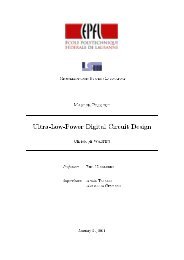Compressive Sensing system for recording of ECoG signals in-vivo
Compressive Sensing system for recording of ECoG signals in-vivo
Compressive Sensing system for recording of ECoG signals in-vivo
Create successful ePaper yourself
Turn your PDF publications into a flip-book with our unique Google optimized e-Paper software.
approximation is discussed by tak<strong>in</strong>g <strong>in</strong>to consideration a different block diagram, which hasbeen considered as a better approximation to the analog implementation <strong>of</strong> a CS path <strong>in</strong> terms<strong>of</strong> power sav<strong>in</strong>g. In the same way, Chapter 6 a new path design has been considered byexploit<strong>in</strong>g an area sav<strong>in</strong>g on chip.B.2.3. Charge ModeAn <strong>in</strong>cremental Sigma-Delta ADC (ΣΔ-ADC), <strong>for</strong> CS applications has been submitted <strong>in</strong> [28]. Thenovelty <strong>of</strong> this implementation is the simultaneity <strong>of</strong> the acquisition and quantization <strong>of</strong> CSmeasurements, due to the fact that a Switched Capacitor (SC) <strong>in</strong>tegrator <strong>of</strong> has been<strong>in</strong>corporated <strong>in</strong> the close loop <strong>of</strong> the converter. The converter occupies a small area <strong>of</strong> 0.047mm 2 on a target 0.5 μm CMOS process, and it can be suitable <strong>for</strong> CS applications. A sketch <strong>of</strong>the complete implementation has been depicted <strong>in</strong> Fig. B.2.3.1.Figure B.2.3.1. Switched Capacitor circuit implementation <strong>of</strong> the CS ADC.In [1] it has been proposed a b<strong>in</strong>ary-weighted SC Multiply<strong>in</strong>g Digital-to-Analog Converter(MDAC) <strong>for</strong> the process<strong>in</strong>g <strong>of</strong> ECG and EMG <strong>signals</strong>. The architecture that is <strong>in</strong>cluded <strong>in</strong>Fig.B.2.3.2. implements a multiplication between the actual random coefficient and the <strong>in</strong>putsignal sample dur<strong>in</strong>g Φ 1 and the accumulation <strong>of</strong> this value dur<strong>in</strong>g Φ 2, these two are settled <strong>in</strong>non-overlapp<strong>in</strong>g. For <strong>in</strong>stead, the first random coefficient which corresponds to element row oneand column one from the random matrix, Φ 11 , and the first signal sample X 1 , are multiplied whenΦ 1 is closed. When Φ 2 is closed, the result is accumulated <strong>in</strong> the <strong>in</strong>tegration capacitance. Onceaga<strong>in</strong>, when Φ 1 is closed, Φ 12 and X 2 are multiplied, and dur<strong>in</strong>g the next high level Φ 2 , the result<strong>of</strong> this operation is added to the previous value has been accumulated, and so on. The MostSignificant Bit (MSB) is used as sign bit.79















